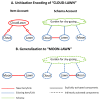The missing link? Testing a schema account of unitization
- PMID: 29744769
- PMCID: PMC6711764
- DOI: 10.3758/s13421-018-0819-3
The missing link? Testing a schema account of unitization
Abstract
Unitization refers to the creation of a new unit from previously distinct items. The concept of unitization has been used to explain how novel pairings between items can be remembered without requiring recollection, by virtue of new, item-like representations that enable familiarity-based retrieval. We tested an alternative account of unitization - a schema account - which suggests that associations between items can be rapidly assimilated into a schema. We used a common operationalization of "unitization" as the difference between two unrelated words being linked by a definition, relative to two words being linked by a sentence, during an initial study phase. During the following relearning phase, a studied word was re-paired with a new word, either related or unrelated to the original associate from study. In a final test phase, memory for the relearned associations was tested. We hypothesized that, if unitized representations act like schemas, then we would observe some generalization to related words, such that memory would be better in the definition than sentence condition for related words, but not for unrelated words. Contrary to the schema hypothesis, evidence favored the null hypothesis of no difference between definition and sentence conditions for related words (Experiment 1), even when each cue was associated with multiple associates, indicating that the associations can be generalized (Experiment 2), or when the schematic information was explicitly re-activated during Relearning (Experiment 3). These results suggest that unitized associations do not generalize to accommodate new information, and therefore provide evidence against the schema account.
Keywords: Familiarity; Recognition; Recollection; Schema; Unitization.
Figures






References
-
- Anderson JR. Effects of prior knowledge on memory for new information. Memory & Cognition. 1981;9(3):237–246. doi: 10.3758/BF03196958. - DOI
-
- Bartlett FC. Remembering: An Experimental and Social Study. Cambridge Univ; Cambridge: 1932.
Publication types
MeSH terms
Grants and funding
LinkOut - more resources
Full Text Sources
Other Literature Sources

